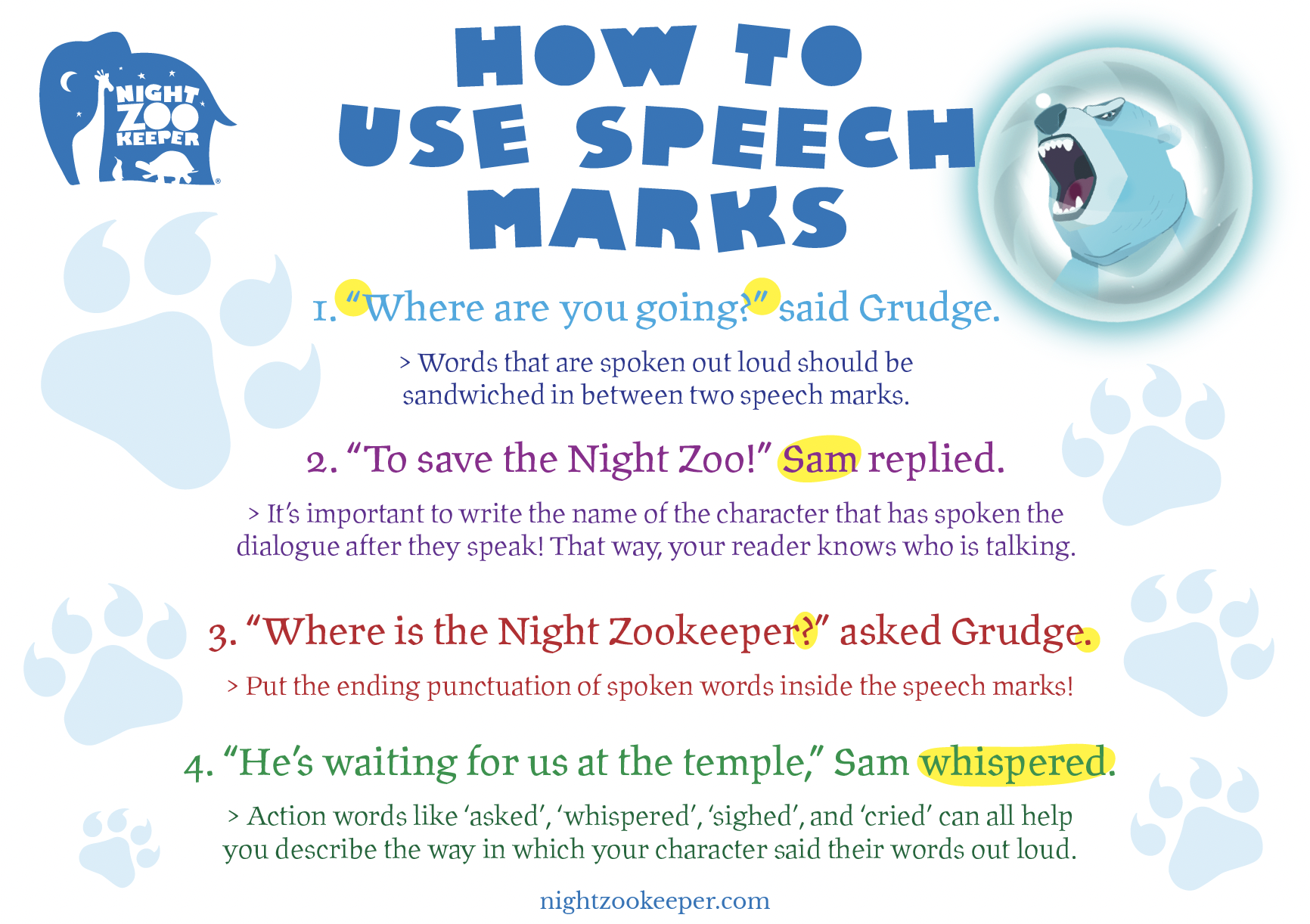Speech Marks
Learn how to use speech marks correctly

Speech marks, also known as quotation marks and inverted commas, are crucial in all styles of writing, from story writing to explanation writing.
We use speech to make a piece of writing as easy to understand as possible. Without proper use, readers may not understand when a character is speaking, or which character is speaking.
In non-fiction writing, a pair of quotation marks/double quotation marks are normally used to add direct quotes or titles to a text. Single quotation marks are used to mark a quote within another quote.
This guide includes lots of examples, tips, and resources to help your child master their use of speech marks. Let’s dive in!

How to use speech marks in dialogue
While learning how to use speech marks in academic writing is important, your child will mainly be using this punctuation mark to add dialogue to their writing. Here are some general rules and different uses for speech marks your child should know:
- Double quotation marks should be used for direct quotes from the character who is speaking.
- They should appear before and after the words being spoken by a character.
- The use of other punctuation marks will still be necessary.
Example
- “That ice cream was delicious!” exclaimed Grudge the Bear.
Notice how in the above example, an exclamation mark is still used at the end of Grudge’s statement to express that he was excited about how delicious his ice cream was! When using a question mark in speech, your child should punctuate the speech marks the same way.
Example
- “Will you go to the movies with me later?” asked Grudge the Bear.
In other instances, when indicating direct speech that would normally have a full stop/period at the end the sentence, we replace it with a comma:
- “I’m going to visit my grandmother later,” explained Grudge the Bear.
Your child can introduce a character before their dialogue by moving the reporting clause to the front of the direct speech, and add a comma after the dialogue tag. In this case, they can then end the speech with a full stop/period, just as they would without speech marks:
- Grudge the Bear explained, “I’m going to visit my grandmother later.”
It’s also important that your child starts a new line whenever they introduce a new speaker.
Example
- Grudge the Bear asked, “Will you go to the movies with me later?”
- “Yes, I’ll get the tickets!” said Florence Flamingo.
Notice how because a new speaker is introduced, your child should do this on a new line. This helps the story look more organized and makes it easier for the readers to know who is speaking and when!
Direct Speech and Indirect Speech
Direct speech is the part of the sentence that’s surrounded by quotation marks. Indirect speech, on the other hand, is not surrounded by speech marks and is just written within the text like any other sentence.
Example
- Direct speech: “Why don’t you want to watch a movie with me?” asked Grudge the Bear.
- Indirect speech: Grudge the Bear asked me why I didn’t want to watch a movie with him.
In the above examples, the same speech is being expressed, but in different ways. In the direct speech example, the question is coming directly from Grudge. However, in the indirect speech example, the author is explaining to the reader the question that Grudge asked. These two ways of expressing the same speech have different implications behind them, which is why an author may choose one type of speech over the other at certain times in their stories.
Other uses for speech marks
- They can sometimes be used to replace italics - this is usually done with shorter direct quotes from books, articles, or films
- To add direct quotations (exact words) to a non-fiction text, like a report or explanation writing piece.
- They let the reader know that the quote in the piece of nonfiction writing is not original, and is being cited from an external source. The quoted material should be followed by parentheses including the original source’s author.
In British English, single quotation marks are used more often, whereas in American English they’re only used to add a quote within a quote.
Activity & resource
Now that your child has learned everything they need to know about speech marks, here's a free resource to help them practice their new skills:

How Night Zookeeper can help

Night Zookeeper makes reading & writing fantastically fun for children.
Our award-winning reading & writing program covers all the essential language skills, from spelling, to grammar, punctuation and reading comprehension.
Sign up today to get a FREE 7-day trial!
More resources
- Capital Letters
- Commas
- Apostrophes
- Punctuation (overview)
Related content


Make Reading & Writing Fantastically Fun!
- Award-winning reading & writing program for kids
- Improves spelling, grammar, punctuation & vocabulary
- Over 1,000 different learning games and activities



